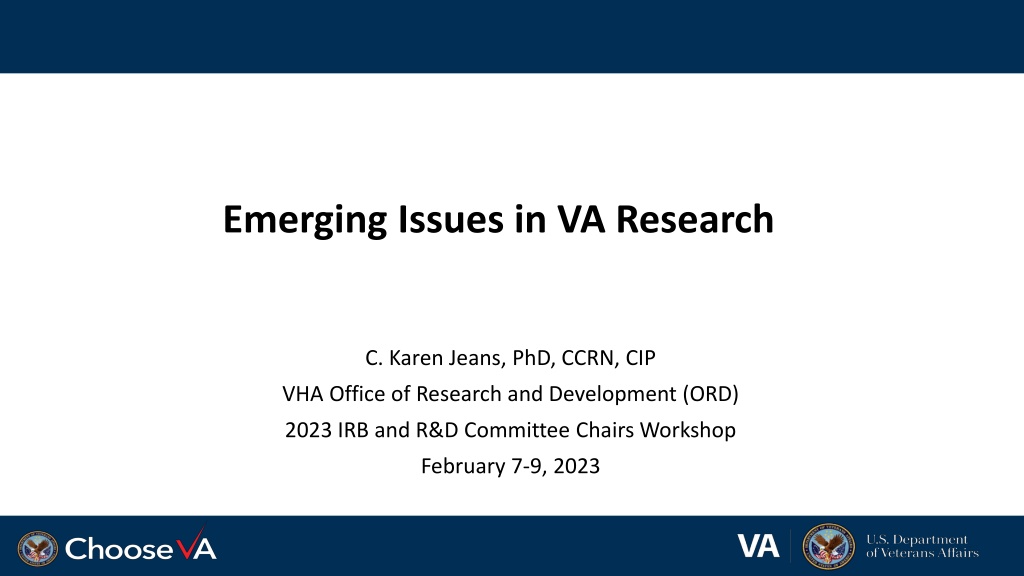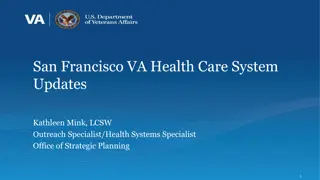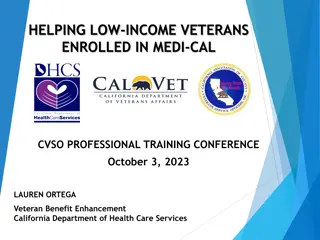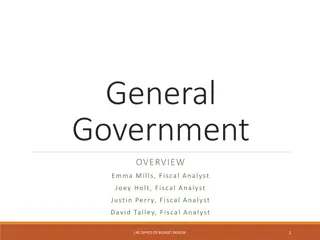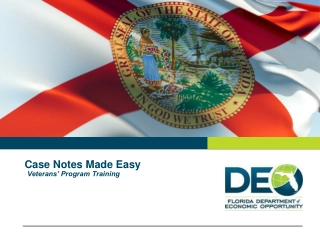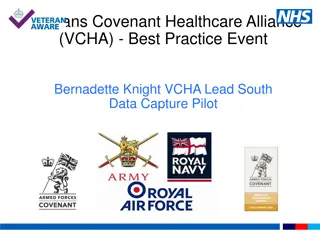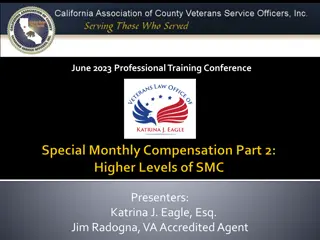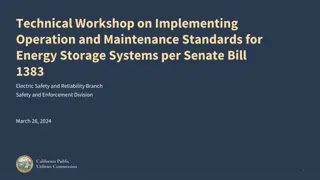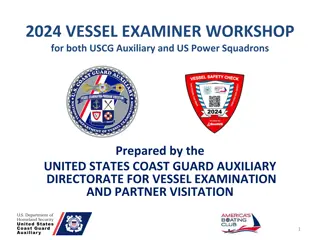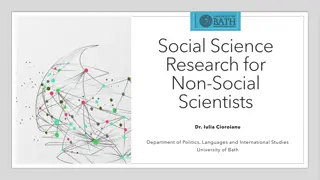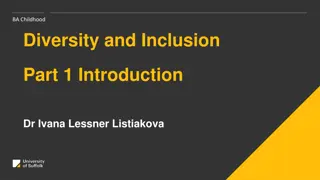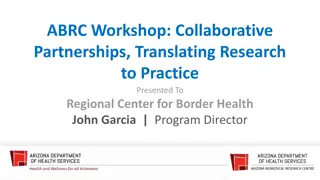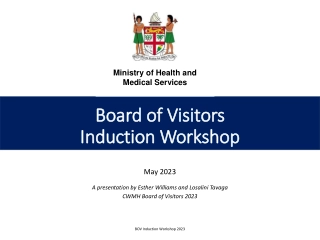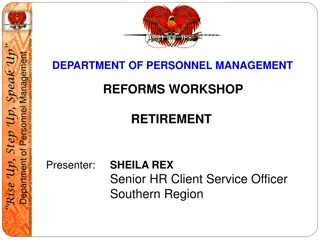Emerging Issues in VA Research Workshop: Inclusion of Non-Veterans
The workshop discusses the inclusion of non-Veterans in VA studies as an emerging issue, focusing on identifying and evaluating issues faced by VA Facility Research and Development Committees. It addresses confusion regarding active duty service military personnel's classification, language in grant applications, and specific approval requirements for non-Veteran inclusion in ORD-funded studies. The distinction between Veterans and active duty military personnel is emphasized, with compliance considerations outlined for research supported by the Department of Defense.
Download Presentation
Please find below an Image/Link to download the presentation.
The content on the website is provided AS IS for your information and personal use only. It may not be sold, licensed, or shared on other websites without obtaining consent from the author. Download presentation by click this link. If you encounter any issues during the download, it is possible that the publisher has removed the file from their server.
Presentation Transcript
Emerging Issues in VA Research C. Karen Jeans, PhD, CCRN, CIP VHA Office of Research and Development (ORD) 2023 IRB and R&D Committee Chairs Workshop February 7-9, 2023
Objectives Objectives Describe issues needing identification and evaluation by VA Facility Research and Development (R&D) Committees when non-Veterans are included in VA studies, with emphasis on ORD-funded studies. Analyze factors for consideration when an IRB or R&D Committee is asked to determine whether VA research data can be used when noncompliance or a lapse of IRB approval has occurred.
Why Are We Discussing Inclusion of Non Why Are We Discussing Inclusion of Non- -Veterans in VA Studies as an Emerging Issue ? Studies as an Emerging Issue ? Veterans in VA Confusion on Whether Active Duty Service Military Personnel are considered Veterans or Non-Veterans; Language in merit or grant applications that infers of inclusion of non-Veterans in a ORD-funded study; and Which ORD funding services require specific ORD approval for inclusion of non-Veterans in an ORD funded study.
Active Duty Service Military Personnel are Non Active Duty Service Military Personnel are Non- -Veterans Veterans Active duty military personnel are not Veterans . As referenced in VHA Directive 1200.01(1), Paragraph 13.c.: In addition to the non-Veterans referenced above, active duty military personnel may be entered into VA research conducted jointly by VA and DoD or within DoD facilities. A Veteran as defined in 38 U.S. Code 101(2) . . . means a person who served in the active military, naval, or air service, and who was discharged or released therefrom under conditions other than dishonorable.
Active Duty Service Military Personnel are Non Active Duty Service Military Personnel are Non- -Veterans (cont.) (cont.) Research supported by the Department of Defense (DoD), including the separate components, the Army, Navy, Air Force and Marine Corps, or recruitment of DoD personnel requires compliance with additional federal regulations, Directives and Instructions. DOD Instruction (DODI) 3216.02 Protection of Human Subjects and Adherence to Ethical Standards in DoD-Conducted and -Supported Research governs all DOD-supported and -conducted research involving human anatomical substances, human data, and human subjects. If the research involves DoD-affiliated personnel as subjects, the DoD has specific requirements. The DODI defines DOD-affiliated personnel as Service members, Reserve Service members, National Guard members, DOD civilians, and DOD contractors. Veterans
Specific Requirements Apply to Active Duty Service Military Specific Requirements Apply to Active Duty Service Military Personnel When Proposed to Be Subjects in VA Research Personnel When Proposed to Be Subjects in VA Research If the proposed research involves access to DOD-affiliated personnel, their data, and/or DOD facilities, a letter of support from the DOD Component or commander of military facilities or units in which recruitment will occur is required. There are other specific requirements that apply dependent upon the research, such as (not all-inclusive): Consent disclosures if the study includes any risks to DOD-affiliated personnel s fitness for duty, Additional reviews by other DoD offices if large scale genomic data (LSGD) collected from DOD-affiliated personnel, For greater than minimal risk research in which DOD-affiliated personnel are recruited in a group setting, an ombudsman must be identified, and Compensation limits and sources of compensation if active military personnel are proposed to receive payment for participation.
Key Points to Remember When Including Active Military Key Points to Remember When Including Active Military Personnel in VA Studies Personnel in VA Studies VA Investigators attempting to access DOD-affiliated personnel as research subjects should consider seeking collaboration with a military investigator who has familiarity with service-specific requirements to obtain access to subjects. Resource for VA Investigators: A Primer for Conducting Department of Defense (DOD) Funded Human Research With Military Populations located at https://mrdc.health.mil/assets/docs/orp/Conducting_Research_Military_Pop_DoD_funded.pdf. If your IRB does not routinely approve research DoD-affiliated personnel, the applicable DoD Component Human Research Protections Office can provide guidance. R&D Committees should evaluate the institutional component (e.g., what is the experience of the institution in recruiting active military personnel in VA studies conducted at the applicable VA Facility).
ORD Approval of Inclusion of Non ORD Approval of Inclusion of Non- -Veterans in ORD Funded Research Veterans in ORD Funded Research VA s research program is Veteran-centric; it focuses on Veterans needs and health care issues. ORD funds research in which the primary subject population is Veterans. However, ORD funding services have mechanisms to allow the inclusion of non-Veterans in ORD funded research. With the exception of the Cooperative Studies Program (CSP), each ORD funding service requires specific approval for the inclusion of non-Veterans in ORD funded research. When an ORD funding service approve the inclusion of non-Veterans in ORD funded research, ORD is assuming the responsibility of paying (or reimbursing) for research-related injuries incurred by a non-Veteran participating in research approved by the R&D Committee.
Regulatory Basis for the Department of Veterans Affairs Coverage of Research Regulatory Basis for the Department of Veterans Affairs Coverage of Research- - Related Injuries for VA Subjects in VA Approved Research: Related Injuries for VA Subjects in VA Approved Research: 38 Code of Federal Regulations (CFR) Part 17.85 Treatment of research- related injuries to human subjects. (a) VA medical facilities shall provide necessary medical treatment to a research subject injured as a result of participation in a research project approved by a VA Research and Development Committee and conducted under the supervision of one or more VA employees. This section does not apply to: (1) Treatment for injuries due to noncompliance by a subject with study procedures, or (2) Research conducted for VA under a contract with an individual or a non-VA institution.
Who Has the Final Authority as to Whether An Injury is a Research Who Has the Final Authority as to Whether An Injury is a Research- - Related Injury? Related Injury? A.Principal Investigator B.VA Facility Chief of Staff C.VA Office of General Counsel D.Jury or judge
VA Does Not Deny Treatment to a VA Subject Who Presents with a VA Does Not Deny Treatment to a VA Subject Who Presents with a Self Self- - Reported Research Reported Research- -Related Injury Related Injury
Key Point to Remember for R&D Committees Key Point to Remember for R&D Committees Non Inclusion in ORD Inclusion in ORD- -funded Studies funded Studies Non- -Veteran Veteran Do not assume that a protocol/merit application approved for funding referring to the inclusion of non-Veterans if insufficient numbers of Veterans can be recruited constitutes the ORD-funding service approving the inclusion of non-Veterans. If ORD approves a Project Modification Request to Include non-Veterans following initial approval and initiation, the R&D Committee must still approve the inclusion of non-Veterans in the research.
What are Recommended Steps if a Research Subject Reports a What are Recommended Steps if a Research Subject Reports a Research Related Injury? Research Related Injury?
Example for Discussion: One Case Example of Initial Steps if a VA Research Subjects Reports a Example for Discussion: One Case Example of Initial Steps if a VA Research Subjects Reports a Research Related Injury Requiring Hospitalization Research Related Injury Requiring Hospitalization Do You Agree? Do You Agree? The Principal Investigator (PI) should communicate with the subject/patient about the injury to obtain sufficient information in order to Notify the IRB and Notify the ACOS/R&D and R&D Committee. The ACOS/R&D or research administrative office (e.g., AO/R&D) needs to notify Risk Management at the VA Facility. OGC Specialty Team Advising Research (STAR). Designate a Point of Contact (POC) for communicating with the VA subject/patient on administrative issues and coordinating communications with stakeholders. For example, the POC would receive any outside bills for processing. If the VA subject has insurance, the subject/patient s insurance cannot be billed.
Key Point to Remember: Ensure the Applicable Groups Have Key Point to Remember: Ensure the Applicable Groups Have Approved the Inclusion of Non Approved the Inclusion of Non- -Veterans in VA Research Veterans in VA Research
Use vs. Non Use vs. Non- -Use of Data Lapse of IRB Approval Occurs? Lapse of IRB Approval Occurs? Use of Data Who Decides When Noncompliance or a Who Decides When Noncompliance or a
Historical Context Historical Context Decades of debate have occurred in research ethics as to whether the results of research that is conducted in an unethical manner should be used to contribute to generalizable knowledge, and if so, which entities involved in the conduct and publication of research should have a role in making that decision. Usually, the proposed method of restricting the contribution to generalizable knowledge is through restrictions on use of the data or human biospecimens, such as publication or other uses. The decisions made in different situations regarding data restrictions do not follow a uniform algorithm. They vary widely depending upon: Ethical issues Regulatory issues
Excerpt of Letter From An Institutional Review Board (IRB) of a Non-VA Study to an Investigator As part of actions taken by an IRB in response to subjects who were enrolled into a clinical intervention study who clearly did not meet inclusion criteria, the IRB made the following determination and communicated it to the Principal Investigator (PI): . . . As a result of the audit conducted by [redacted] in which 8 of 22 subjects did not meet the inclusion criteria between June 7, 2022 and November 1, 2022, the IRB has made a determination of serious and continuing noncompliance and also determined that you may not use any of the data generated from the subjects who did not meet the inclusion criteria . . .
What is Meant by You May Not Use Any of the Data? If one analyzes different IRB standard policies and procedures, one can find wide variances in what various IRBs define as actions they can take as result of serious and continuing noncompliance.
For Your Consideration: Can an IRB decide whether data can be published or prohibited from being published in a journal or presented in presentations? OR
Also, For Your Consideration: Can an IRB require data to be destroyed?
For Your Consideration with Should: Should an IRB decide whether data can be published or prohibited from being published in a journal or presented in presentations? OR
Also, For Your Consideration with Should: Should an IRB require data to be destroyed?
The IRBs Scope of Authority The Federal Policy for the Protection of Human Subjects (Common Rule codified by VA as 38 Code of Federal Regulations (CFR) Part 16) dictates the scope or purpose of IRB activities for an IRB reviewing research subject to its regulations. An IRB shall review and have authority to approve, require modifications in (to secure approval), or disapprove all research activities covered by this policy, including exempt research activities under 16.104 for which limited IRB review is a condition of exemption (under 16.104(d)(2)(iii), (d)(3)(i)(C), (d)(7), and (d)(8) . An IRB shall have authority to suspend or terminate approval of research that is not being conducted in accordance with the IRB s requirements or that has been associated with unexpected serious harm to subjects. . . . Reference: 38 CFR Part 16.109(a) Reference: 38 CFR Part 16.113
What is the Answer to Your Question Based Solely Upon the Common Rule Language? Should an IRB decide whether data can be published or prohibited from being published in a journal or presented in presentations? OR
What is the Answer to Your Question Based Solely Upon the Common Rule Language? Should an IRB require data to be destroyed?
Why the Words Associated with Use of Data are Problematic without Clarification: Does it mean: Sequestering the data? Not allowing monitors access (for an outside monitored study)? Not permitting the data to be used in analyses? Not permitting the data to be reported to FDA or sponsors? Informing the Investigator that the data may not be used in publications? Informing publishers that the data cannot be used in publications?
What are Some of the Ethical Aspects of an IRB Not Permitting Use of Data in Any Way? Does it mean: The subjects are informed? More subjects are entered to make up for the excluded subjects? Excluded subjects are not eligible for research-related injury treatments?
IRBs Scope of Authority This is not unique to VA An IRB must operate within its scope of authority. If it operates outside of its scope of authority according to the Common Rule (for an IRB reviewing research subject to the Common Rule), then those authorities must be given to the IRB through another mechanism (such as institutional authority).
Case #1: Lack of Written HIPAA Authorization The IRB approved a clinical trial evaluating different doses and delivery of radiation therapy for gliobastomas. Fourteen (14) VA subjects were enrolled in the first year. In the annual Research Compliance (RCO) audit, the Principal Investigator (PI) could not locate seven (7) subjects written HIPAA authorizations for research. The IRB determined that the event of the missing subjects written HIPAA authorization constituted serious and continuing noncompliance. The PI attempted to obtain the written HIPAA authorizations from the seven subjects, but the PI was unable to obtain after multiple attempts over seven months.
Case #1: Lack of Written HIPAA Authorization (cont.) The clinical trial sponsor wrote a letter to the IRB requesting approval for the data to be used . The IRB met during a convened meeting and recommended the use of the data with the missing written HIPAA authorizations. The IRB wrote in its justification that it was unethical to restrict the data because of the intervention received from the subjects and made recommendations to the R&D Committee for it to allow the use of the data. The R&D Committee approved the IRB s recommendation to allow the use of the data.
Did the R&D Committee Have the Authority to Allow Unrestricted Data Use in the Absence of Written HIPAA Authorizations?
Did the R&D Committee Have the Authority to Allow Unrestricted Data Use in the Absence of Written HIPAA Authorizations? NO
Case #1: Why the R&D Committee Did Not Have the Authority to Case #1: Why the R&D Committee Did Not Have the Authority to Make its Determination Make its Determination Case #1 involves a privacy issue under the scope of VA and VHA privacy regulations and laws, including the HIPAA Privacy Rule and the Privacy Act of 1974. The failure to obtain a HIPAA Authorization for research from the seven subjects results in the inability of the VA Investigator to use the data collected from that subject until: The subject signs a HIPAA Authorization; or The IRB or Privacy Board approves a Waiver of HIPAA authorization due to the inability to obtain signature on a HIPAA Authorization. The R&D Committee (or anyone else at the institution) cannot make determinations that violate applicable law.
Case #2: Lapse of Continuing Review Approval Case #2: Lapse of Continuing Review Approval An interventional study using two different behavioral therapy techniques for traumatic brain injury (TBI) was approved on October 2, 2021. The study is sponsored by industry. Due to circumstances outside of the PI s control, no continuing approval application was submitted; IRB approval expired on October 1, 2022. Twenty-nine (29) subjects were in the active intervention phase during the period of lapsed approval. All were allowed to continue the intervention by the IRB Chair because of harm that could have resulted from removal of the therapy. Forty-five (45) subjects were in follow-up during this period for safety monitoring. The PI completed all continuing review requirement, and the IRB reapproved the study on November 15, 2023.
Case #2: Lapse of Continuing Review Approval (cont.) Case #2: Lapse of Continuing Review Approval (cont.) The PI sent the IRB correspondence from the sponsor requesting the IRB make a determination whether the data obtained during the period of expired IRB approval could be used . The IRB contacted the R&D committee for guidance. The R&D Committee informed the IRB that it was the IRB s responsibility to determine whether the data could be used . The IRB determined that the data could be used , but the PI must disclose to the editors or presentation reviewers that data obtained from October 1, 2022 thru December 14th was data obtained without IRB approval. The sponsor appealed to the IRB, stating that the IRB was interfering with a groundbreaking study and its ability to be published based on a bureaucratic technicality. The IRB did not change its determination.
Did the IRB Have the Authority to Make a Determination that the PI must disclose to the editors or presentation reviewers that data obtained from October 1, 2022 thru December 14th were data obtained without IRB approval?
Did the IRB Have the Authority to Make a Determination that the PI must disclose to the editors or presentation reviewers that data obtained from October 1, 2022 thru December 14th were data obtained without IRB approval? YES
Case #2: Lapse of Continuing Review Approval (cont.) Case #2: Lapse of Continuing Review Approval (cont.) The data obtained during the period of IRB lapsed approval is data obtained without IRB approval. The IRB cannot retrospectively grant IRB approval to data which was collected during a period of IRB expiration. The R&D Committee also made the correct guidance in requiring the IRB to make the initial determination regarding the sponsor s request as to whether the data obtained during IRB expiration could be used .
Summary Summary The issues surrounding determinations on data restriction are complex and often situational specific. While the Common Rule does not directly address restriction of research data use, there are some IRBs that have decided to assume that responsibility with (or without) the institution granting that authority. ORD policy in VHA Directive 1200.01(1) does not directly address the R&D Committee s authority to determine restriction of research data use, but some R&D Committees have decided to assume that responsibility as part of institutional governance. It is imperative to consider applicable regulatory and legal issues when making decisions on whether to apply data restrictions when data is obtained during lapsed IRB approval or resulting from noncompliance.
Contact Information Contact Information ORD Regulatory Box: VHACOORDREGULATORY@VA.GOV
References References A Primer for Conducting Department of Defense (DOD) Funded Human Research With Military Populations, November 7, 2022 located at https://mrdc.health.mil/assets/docs/orp/Conducting_Research_Military_Pop_DoD_funded.pdf DOD Instruction (DODI) 3216.02 Protection of Human Subjects and Adherence to Ethical Standards in DoD-Conducted and Supported Research April 15, 2020; Change 1 Effective June 29, 2022; located at https://www.esd.whs.mil/Portals/54/Documents/DD/issuances/dodi/321602p.pdf The Secretary s Advisory Committee on Human Research Protections, Attachment A - IRB Authority to Restrict Use of Data Collected and Developed in Research, March 29, 2021 accessed at https://www.hhs.gov/ohrp/sachrp-committee/recommendations/attachment-a-irb-authority-use- data-collected-and-developed.html. (VHA Directive 1200.01(1): Research and Development Committee (issued January 24, 2019; amended January 8, 2021) at VHA Publications VHA Directive 1200.05(2): Requirements for the Protection of Human Subjects in Research (issued January 7, 2019; amended March 3, 2020 and January 8, 2021) at VHA Publications.
Questions Questions
